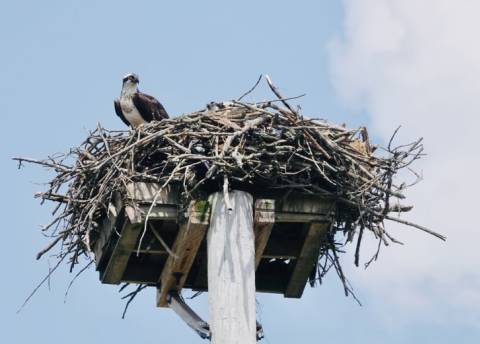Ospreys are also known as “fish hawks” and “sea eagles,” names that refer their diet and habitat, and “bald buzzards,” which sort of describes their white-headed appearance. Here are a few facts about this unique bird of prey.

1. Ospreys live on every continent except Antarctica.
Ospreys are one of the most widely distributed birds of prey. In North America, most ospreys spend the warmer months in Canada, Alaska, the Eastern seaboard, and parts of the Pacific Northwest, and then migrate to Southern California and the Gulf Coast in winter. They’re found in marshes and wetlands, along rivers and streams, and on seacoasts.
2. Osprey means “bird of prey.”
Osprey emerged in the mid-1400s from the Anglo-French word ospriet, which itself derived from the Medieval Latin phrase avis prede or “bird of prey.” The first part of its scientific name, Pandion haliaetus, comes from the name of mythological kings of Athens, and second part from the Greek words for “sea” (halos) and “eagle” (aetus).
3. Fish make up more than 99 percent of an osprey’s diet.
Unlike other raptors, which eat omnivorous diets of whatever’s available, ospreys eat fish exclusively. But they’re not picky about which fish: In North America, they are known to consume 80 freshwater and saltwater species. According to the Cornell Lab of Ornithology, an osprey’s typical prey will measure between 6 and 13 inches in length and weigh less than a pound, though exceptions have been documented. In 2020, beachgoers in South Carolina captured video of an osprey apprehending what looks like a small shark (above).
4. Ospreys don’t need to drink water.
Their fishy diet generally supplies all of the hydration they need.
5. Ospreys capture prey in a unique way.
To locate prey, ospreys glide high in the air over a body of shallow water, looking for fish with their keen vision. When they spot one, they will dive toward the surface, extending their legs and talons forward just before hitting the water. Once the fish is caught, the bird flaps its long wings to lift itself up. Unlike eagles or hawks, ospreys will always catch and hold its prey head-first to reduce wind resistance as they fly [PDF].
6. Ospreys’ feet help them fish.
Ospreys have several adaptations that make them expert anglers. One is “facultative zygodactyly,” the ability to rotate one of their three front toes backwards to grip slippery fish more securely. The inside surface of their feet is covered with tiny points called spicules, which, with their long, curved, and very sharp talons, also give them more traction when grasping prey.
7. Ospreys will add trash to their nests.
Ospreys build large nests, called eyries, on top of trees, telephone poles, buoys, or human-made nesting platforms near wetlands. The nests consist of sticks, reeds, and grasses, and those located near towns or cities might also include nylon netting, plastic bags, or other garbage. Once they successfully lay and raise eggs in their nest, ospreys will return to it year after year, adding additional sticks each time. But if an osprey pair fails to raise chicks for some reason, they’ll build a new nest—dubbed a “frustration eyrie”—nearby.
8. Osprey nests are hot real estate for other animals.
Osprey nests are huge: a newly built one can measure 5 feet across and 2 feet deep, and one that’s been added to for several years can be 6.5 feet deep. Other species often use these sturdy structures for their homes. Cavity-nesting birds like tree swallows and common grackles build their nests inside them, while great blue herons, bald eagles, common ravens, and great horned owls raise chicks on them in winter, when the adult ospreys are in warmer climes.
9. People used to collect osprey eggs as a hobby.
Amateur naturalists in the 19th century dabbled in oology, the collection and study of wild birds’ eggs. The fad led to big decreases in some bird populations, including ospreys, whose cream-colored eggs are mottled with red, gray, or brown and are roughly the size of chicken eggs. In the UK, where osprey populations haven’t yet recovered from the impact of the Victorian oologists, laws protecting wild birds and outlawing egg collecting have been on the books since 1880. In the U.S., the Migratory Bird Treaty Act of 1918 outlaws the collection, possession, buying, selling, or transporting of wild birds’ eggs, among many other provisions.
10. Ospreys came back from the brink of extinction.
Egg-collecting and hunting were the biggest threats to ospreys before the introduction of DDT in the mid-20th century. The pesticide caused eggs to have thin shells and break easily, and the U.S. populations of many raptors, including ospreys, plummeted between the 1950s and 1970s. Fortunately, the 1972 ban on DDT and the placement of human-made nesting platforms helped ospreys recover. Their overall population grew by 2.5 percent each year between 1966 and 2015, though they remain more populous on the coasts than inland.
11. Climate change might force ospreys north.
Ospreys will live almost anywhere there is shallow water with abundant fish and suitable structures for their nests, but the warming climate may shift their current U.S. range north. The National Audubon Society’s model predicts that if we maintain the current warming trends, osprey populations stand to lose habitat around the mid-Atlantic, Great Lakes, and upper Great Plains and gain habitat across sub-Arctic Canada. With a global temperature increase of 2°C, which could occur as early as 2050, the effect will be even more drastic.
